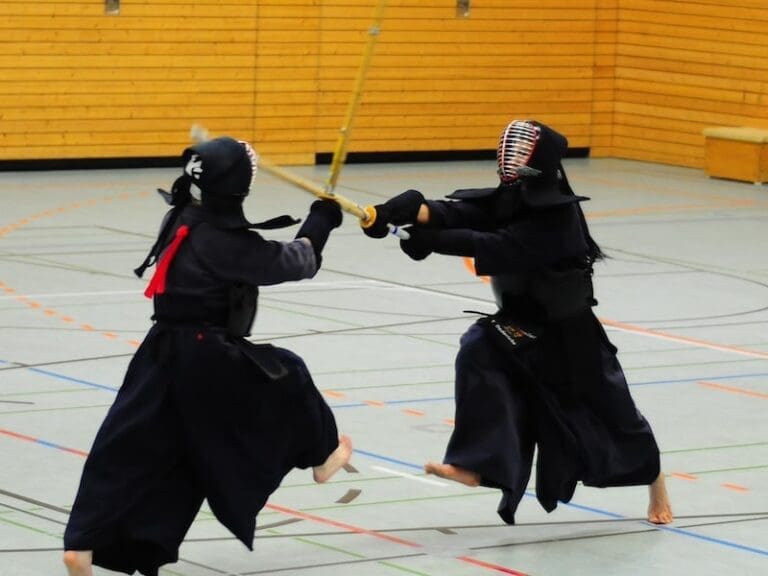To me, kendo has always been the Japanese version of fencing. They’re both a combat sport featuring sword fighting. They’re both taught in school (I still remember my fencing PE classes in France). And they both trace back centuries. Now though, kendo is much more part of the Japanese culture than fencing is part of the Western culture.
Kendo has been gaining international popularity, and for travelers visiting Japan there are actually ways to try your hand at kendo in very authentic ways. But let me first introduce this sport before showing you where you can experience it in Tokyo and Kyoto on your next trip to Japan.
What is Kendo?
Kendo, or the “way of the sword”, is the martial art of swordsmanship—and has been famous in Japanese culture for centuries. It teaches different techniques and styles using bamboo swords and protective armor. However, Kendo is not just about a physical technique; it places focus on mental and spiritual aspects, too.
Kendo has ties to the samurai who served the lords of Japan for centuries, making it a discipline with a great sense of tradition. While it doesn’t have strong religious ties, it still teaches concepts such as respect and discipline.
Kendo usually takes place in a dojo (a training hall where martial arts are practiced). The practitioners, called kendoka, follow a strict code of etiquette—including bowing, wearing traditional kendogi and hakama (uniform), and showing respect to instructors as well as fellow practitioners.
This practice uses a dan and kyu system to rank practitioners. Dan ranks indicate a kendoka’s skill—and represent black belt levels. Kyu ranks, on the other hand, are lower-level ranks. These are usually achieved before a black belt.
What Equipment is Used for Kendo?
Kendoka use specific equipment for this practice, including:
- Shinai — A bamboo sword constructed from four bamboo slats. It is used for striking.
- Bogu — Protective armor worn by Kendoka. It includes headgear for the face and neck (men), gauntlets for the hands (kote), and a chest protector for the torso (do). A groin protector (tare) is also often used.
- Keikogi — A traditional jacket made from cotton
- Hakama — A pleated garment resembling a skirt
- Tenugui — A cloth for wiping sweat during the practice
- Men Himo and Do Himo — Straps to secure the protective gear
- Kendo Bag — A bag designed to carry Kendo equipment.
History of Kendo
Kendo has its roots in the samurai traditions of Japan—where swordsmanship was highly valued. The samurai were the warrior class in feudal Japan who initiated this practice even before the 17th century.
Over the years, it evolved from a martial art into a modern sport as well as discipline. It especially gained popularity in the 20th century, when kendo organizations were established even outside of Japan.
Today, it is practiced throughout the world—but to have a true taste of the experience, Japan is where to head!

Did You Know?
Before we talk about where to get the best kendo experience, here are a few fun facts about the practice:
- The kendo uniform isn’t just practical; it reflects the samurai class who initiated this practice.
- In kendo competitions, you are awarded points in a unique way: based on striking the opponent’s body on specific target areas. This helps perfect precision and control.
- The modern sword for kendo, called shinai, is made from bamboo and is designed to minimize the risk of injuries.
- Kendo has no age limits; even children can practice it. In fact, it is famous in schools across Japan as a physical practice.
Best Kendo Experiences in Japan
Ready to try kendo for yourself? It makes for a great activity to add to your next Japan itinerary, especially to have a true feel of the Japanese culture. Below, we round up the best kendo experiences in Tokyo and Kyoto.
| Location | Price | Unique Features | Booking Link |
| Uguisudani Station, Tokyo | ¥18,000 per adult | – Friendly guide teaches about Kendo, its history, and popularity – Basic skills and etiquette taught, including wearing the armor and using the sword – Duration: 2 hours | Book on Klook |
| Taito, Tokyo | ¥18,000 per adult | – An English-speaking, experienced instructor – All equipment and armor included – Skills tested at tournament-style combat game – Complimentary drinks and a souvenir – Kendo towel provided – Duration: 2 hours | Book on TripAdvisor |
| Sakyo Ward, Kyoto | ¥160,000 per group | – Private class, only for your group – Includes a lecture on Kendo by English-speaking instructor Tomoyoshi Yamanaka, a samurai family descendant – The experience takes place at a stunning traditional kendo dojo – Don a Kendo armor and learn the basic movements – Test your new skills in a friendly Kendo match – Certificate of Experience awarded Duration: 2 hours | Book on Wabunka |
Final Thoughts
Immersing in kendo in Japan is one of the best things you can do on your trip to the country. Not only does it give you good physical exercise, but it also teaches you more about the history and culture of Japan. After you’ve enjoyed your kendo experience in Tokyo or Kyoto—you’ll have the urge to learn more and perfect the skill once you’re back home. And, who knows… you may find your next favorite hobby!


Comments are closed.